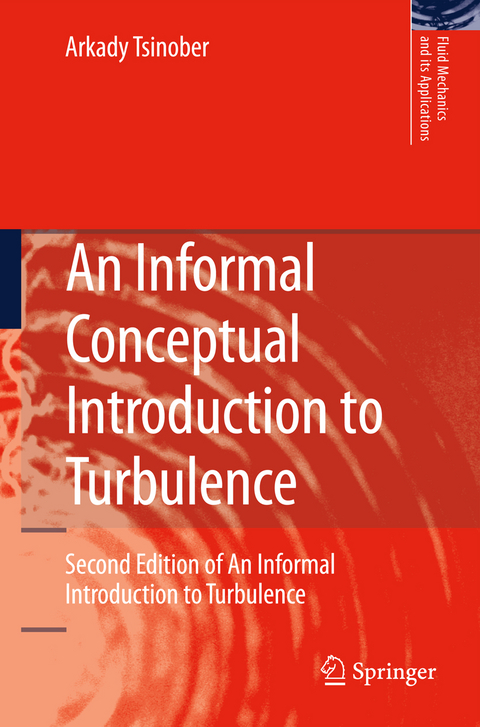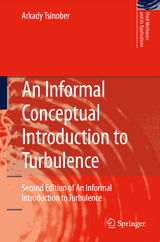An Informal Conceptual Introduction to Turbulence
Second Edition of An Informal Introduction to Turbulence
Seiten
2009
|
2nd ed. 2009
Springer (Verlag)
978-90-481-3173-0 (ISBN)
Springer (Verlag)
978-90-481-3173-0 (ISBN)
This fully revised second edition focuses on physical phenomena and observations in turbulence, and is focused on reversing misconceptions and ill-defined concepts. New topics include ergodicity, Eulerian versus Lagrangian descriptions, theory validation, and anomalous scaling.
The subject of turbulence remains and probably will remain as the most exciting one for the mind of researchers in a variety of ?elds. Since publication of the ?rst edition of this book in November 2001 a number of otherbooksonturbulencehaveappeared,forexampleBernardandWallace (2002), Oberlack and Busse (2002), Foias et al. (2001), Biskamp (2003), Davidson(2004),Jovanovich(2004),SagautandCambon(2008)tomention afew. Soonehastoaskagain thequestionwhyasecondeditionofonebook from a ?eld of so many on the same subject? Does it make any di?erence? Thereareadditionalreasonsapartofthosegiveninthe?rstedition. One of thebasic premises of this bookis thatWeabsolutelymustleave roomfor doubtor thereis noprogress and nolearning. Thereis nolearning without posing a question. And a question requires doubt...Now the freedom of doubt,whichisabsolutelyessentialforthedevelopmentofscience,wasborn from astruggle with constituted authorities...R. Feynmann (1964). This is closely related to the term 'conceptual ': the book has now a di?erent title An informal conceptual introduction to turbulence. One of the main f- tures of the ?rst edition was indeed its conceptual orientation.
The second edition is an attempt to make this feature dominant. Consequently items whicharesecondaryfromthispointofview werereducedandeven removed in favour of those added which are important conceptually. This required addressing in more detail most common misconceptions, which are con- quencesoftheprofounddi?cultiesofthesubjectandwhichtravel fromone publication to another. Consequently a one page Appendix D listing some of these misconceptions in the ?rst edition became chapter 9 titled Ana- gies,misconceptions and ill de?ned concepts.
The subject of turbulence remains and probably will remain as the most exciting one for the mind of researchers in a variety of ?elds. Since publication of the ?rst edition of this book in November 2001 a number of otherbooksonturbulencehaveappeared,forexampleBernardandWallace (2002), Oberlack and Busse (2002), Foias et al. (2001), Biskamp (2003), Davidson(2004),Jovanovich(2004),SagautandCambon(2008)tomention afew. Soonehastoaskagain thequestionwhyasecondeditionofonebook from a ?eld of so many on the same subject? Does it make any di?erence? Thereareadditionalreasonsapartofthosegiveninthe?rstedition. One of thebasic premises of this bookis thatWeabsolutelymustleave roomfor doubtor thereis noprogress and nolearning. Thereis nolearning without posing a question. And a question requires doubt...Now the freedom of doubt,whichisabsolutelyessentialforthedevelopmentofscience,wasborn from astruggle with constituted authorities...R. Feynmann (1964). This is closely related to the term 'conceptual ': the book has now a di?erent title An informal conceptual introduction to turbulence. One of the main f- tures of the ?rst edition was indeed its conceptual orientation.
The second edition is an attempt to make this feature dominant. Consequently items whicharesecondaryfromthispointofview werereducedandeven removed in favour of those added which are important conceptually. This required addressing in more detail most common misconceptions, which are con- quencesoftheprofounddi?cultiesofthesubjectandwhichtravel fromone publication to another. Consequently a one page Appendix D listing some of these misconceptions in the ?rst edition became chapter 9 titled Ana- gies,misconceptions and ill de?ned concepts.
Origins of Turbulence.- Methods of Describing and Studying Turbulent Flows.- Kinematics.- Phenomenology.- Dynamics.- Structure(s) of Turbulent Flows.- Turbulence Under Various Influences and Physical Circumstances.- Analogies, Misconceptions and Ill-Defined Concepts.- Conclusion/Close.- Appendix A. What is Turbulence?.- Appendix B. About the ‘SNAGS’ of the Problem.- Appendix C. Glossary of Essential Fluid Mechanics.- Appendix D: Glossary of Some Terms.
| Erscheint lt. Verlag | 5.9.2009 |
|---|---|
| Reihe/Serie | Fluid Mechanics and Its Applications ; 92 |
| Zusatzinfo | XX, 464 p. |
| Verlagsort | Dordrecht |
| Sprache | englisch |
| Maße | 154 x 237 mm |
| Themenwelt | Technik ► Maschinenbau |
| ISBN-10 | 90-481-3173-1 / 9048131731 |
| ISBN-13 | 978-90-481-3173-0 / 9789048131730 |
| Zustand | Neuware |
| Haben Sie eine Frage zum Produkt? |
Mehr entdecken
aus dem Bereich
aus dem Bereich
Buch | Softcover (2023)
Springer Vieweg (Verlag)
24,99 €
Normung, Berechnung, Gestaltung
Buch | Softcover (2023)
Springer Vieweg (Verlag)
39,99 €
Buch | Softcover (2023)
Springer Vieweg (Verlag)
24,99 €




